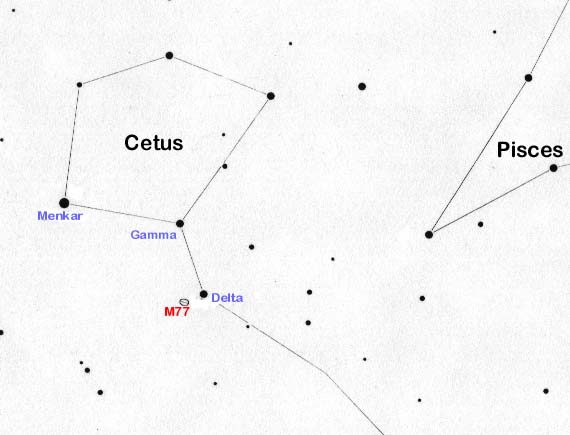![]()
![]()
Spring and autumn are the best seasons for galaxy observing. Leo and Virgo, two spring constellations, are home to hundreds of distant star cities that can be observed with amateur telescopes. The autumn constellations, Pegasus, Aries, Pisces and Cetus, also harbor a sea of galaxies. The reason these seasons are so galaxy-rich is simple. The night side of Earth is oriented such that we are looking through the thin disk of the Milky Way. The North Galactic Pole is located in Coma Berenices amidst the spring galaxies. The South Galactic Pole resides in Sculptor just across the border from Cetus. Understanding the orientation of our planet with respect to the outlying universe explains a lot about the types of objects we are able to enjoy as the seasons change.
| Autumn Sky Tour: M77 (Cetus) RA: 02h 42.7m / DEC: -00° 00'.8 |

|
In much the same way, understanding the true nature of a galaxy can make the observing experience more enjoyable. Most galaxies show very little structure, especially when observed with a small telescope. One such galaxy resides in Cetus, the sea monster. The head of the sea monster is a pentagonal arrangement of naked eye stars, the brightest being 2.5 magnitude Menkar. Menkar is about 220 light-years distant which means the light we see began its journey toward Earth about the same time as the American Continental Congress was drawing up the United States Constitution.
The head is connected to the body by a long neck. Delta Ceti is a 4.0 magnitude star in the neck. In fact, it's the first star you'll encounter while snaking your way from the head of Cetus to the body. M77 is 52' to the southeast. Center Delta Ceti and slew about half-a-degree due east. You should sweep up a pair of 7th magnitude stars separated by about 8 arc minutes. M77 is 35' south-southeast of this pair.
|
|

Home | About Cosmic Voyage | Getting Started | Deep-sky Observing | Planetary Observing | Astrophotography | Sketching | Glossary | Web Links
URL: http://www.cosmicvoyage.net
Layout, design & revisions © W. D. Ferris
Comments and Suggestions: wdferris1@gmail.com
Revised: February 14, 2002 [WDF]